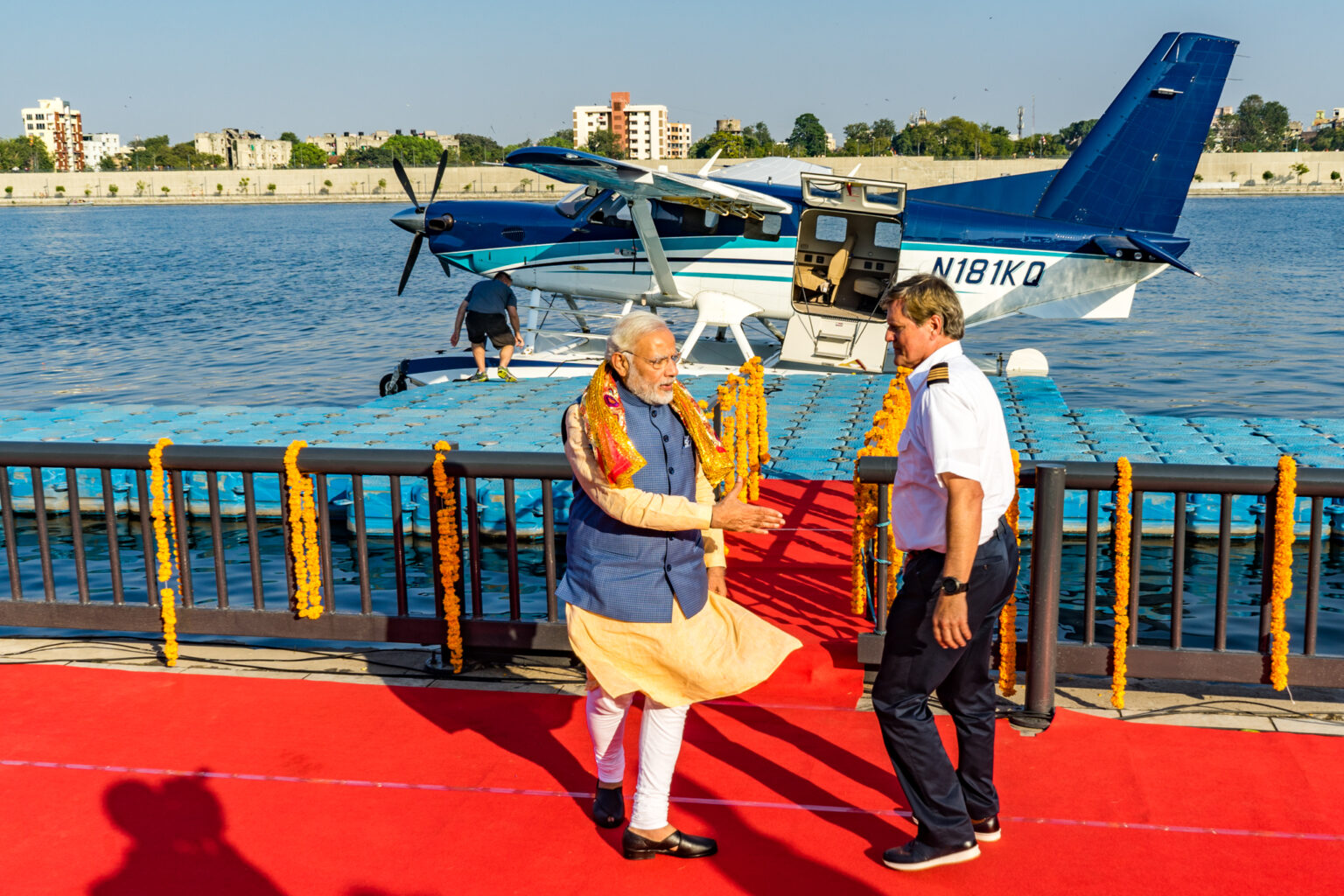Part 5 of: What is the Difference Between a Floatplane and a Seaplane?

One of the more questionable quotes I often hear seaplane promoters say is that 71% of the world is covered by water. Ok, but we can land in only 1% of that area 70% of the time. I confess I made that last part up, but it represents my floatplane experience. Flying boats, however, had a much broader reach.
Before aviation, coastline bays and harbours were home to most of the world’s population because ships were the only transport between the West and East and the North and South trading centers. Spice, salt, pepper, hemp, cotton, gold, copper, you name it, came in via ships. People lived where they prospered.
Bays and harbours were strategic locations for the navy and merchant ships, so they became the obvious locations for seaplane bases.
The pre-war Pan Am seaplane fights started from Key West to Havana in 1927. In 1935, a Pan Am Sikorsky S-42 Clipper flew from San Francisco to Hawaii, harbour to harbour. From their single flight to Havana in 1927, they had grown their route to 250 destinations in 55 countries, flying 130 Clippers by 1939, with plans to expand.
Seaplanes dominated aviation because there were so few runways or airports.

Like in the Mesozoic period, when dinosaurs ruled the Earth, flying boats ruled the waves from the early Thirties until the end of World War II. The dinosaurs’ rule died after a cataclysmic event, and the same goes for flying boats. The Second World War was a catastrophic event that ushered in the modern world.
The flying hulls of World War II, the PBY, the Goose, the Mallard, the Albatross, and many others provided seaplane services to all parts of the world. They saved numerous lives in relief and rescue operations, often in the worst weather conditions. Flying boats were proven capable of handling open-water seas.
The time between the invention of the airplane and the end of the Second World War was equivalent to the batting of a brontosaur’s eyelash. The demand for heavy transport and bomber aircraft created a demand for large, paved runways and airports. Consequently, governments, under the threat of losing the war, invested in and built international airports.
The advent of airports was the demise of seaplanes and, specifically, flying boats. Landplanes were cheaper to build, maintain and operate. They could also be built larger to carry more passengers and freight. The economy of scale favoured the aircraft on wheels landing at large airports and, consequently, large population centers. Remember, people live where they prosper.

Pan American Airways, with its 100-plus flying boats, was also known as the “American Merchant Marine of the Air.” In 1939, the U.S. Congress signed the Neutrality Act, preventing Americans from entering the war. The American President, Franklin D. Roosevelt, knew they could not remain neutral forever and conscripted Pan Am to assist in every neutral way possible, especially aiding the British in the North Africa conflict. By December 15th, 1942, Pan Am’s Clipper fleet and their pilots were turned over to the Army Air Transport Command. The age of elegance, flying the humongous and ultra-luxurious Boeing 314 Clipper of the Seas, had ended. The Army stripped the Clipper’s plush first-class interiors and painted their exteriors a dull gray.
By the end of the war in 1945, the Sikorsky and Martin flying boats had become outdated and were relegated to the backwater routes of Africa. The Boeing Clipper, the grand dame of aviation, had an unfortunate series of accidents, making the new fast, reliable, war-surplus DC-4 the airliner of choice. In rapid succession, the Lockheed Constellation, the Boeing Stratocruiser, the DC-8, and, ultimately, the world-ranging Boeing 707 superseded anything built to fly on water.
Pan Am and flying boats helped shrink the world and bring an enduring world peace unlike any known before. The soldiers and sailors, forced into eye-opening travel during the war, and their burgeoning baby-boomer middle-class families enjoying the prosperity of the 1950s and 60s became the new globe trotters. Ticket prices dropped thanks to the economy-of-scale of airport-to-airport jet travel. Airliners like Pan Am no longer had to fund and maintain their infrastructure. Cities, municipalities, states, and countries saw the benefit of building and funding international and regional airports for all airlines. Privately owned seaplane bases disappeared or were integrated into marine harbours. The era of the flying boats came to a quick and painless end.
Boeing, Lockheed, and Douglas concentrated on building bigger and faster airliners. Lufthansa introduced Economy Class to their B707 in 1960. The Beatles flew into New York on a Pan Am B707 Jet Clipper in 1965. I flew to Sydney, Australia, on an American Airlines B707 in 1971, sans the Beatlemania reception. During this era of economic growth in North America and Western Europe, city populations continued to grow at the expense of rural towns. More people left the farms and forests to live and work in the city. Middle-class families from “first world” nations prospered and wanted to see the world, and the airlines provided the means.
Regional travel elsewhere was restrictive and sporadic. Regional airlines came and went, prospered and died with the economic winds. The 1973, 1980, 1990, 2001, 2008, and 2020 economic downturns ended growth spurts that had promised increasing passenger numbers. Despite these disruptions, regional passenger air travel has outpaced annual growth in GDP worldwide, with the new-to-EU and Indo-Pacific countries leading the way.

The tipping point comes when middle-income families living in the quickly growing population centers in Indonesia, India, Japan, Maldives, Thailand, Vietnam, South Korea, Sri Lanka, Bangladesh, Philippines, Fiji, China, and many other developed countries can afford to travel regionally. These prosperous potential passengers live in countries that don’t have airports in every little city or town—countries that don’t have the infrastructure that Europe, Canada, or America have. How can they travel for pleasure or business?
Conversely, how can tourism and business representatives reach promising remote locations without direct “feeder” regional flights? It is an economic truth that dependable and affordable air service leads to regional growth. Greece, Turkey, Croatia, Costa Rica, Panama, Brazil, Venezuela, and many other South American countries could benefit from increased regional connections.
The world’s governments also recognize that economic growth and opportunities lead to a better quality of life and further economic growth and opportunities.
Today, the Indo-Pacific makes up more than one-third of all global economic activity. Three of the world’s largest economies—the People’s Republic of China (China), India and Japan—are in this part of the world. By 2040—less than two decades from now—the region will account for more than half of the global economy, or more than twice the share of the United States. By 2030, it will be home to two thirds of the global middle class, having lifted millions out of poverty through economic growth. The region also includes nearly two-thirds of the world’s oceans and is among the most vulnerable globally to the effects of climate change.
That is where modern seaplanes come in.
Cessna, Piper, Beech, and DeHavilland all concentrated on building regional landplanes, albeit with the connections needed to add float gear when required. There was a small market in Canada and Alaska for aircraft to operate on water, so companies such as Edo, CAP, PK, and Wipline provided the floats needed to make the conversion.
Floatplanes were primarily flown into inlets, lakes and rivers, i.e., flat water, to support remote locations. Indigenous communities, mineral exploration, oil seismic surveys, commercial fishing, and sport fishing camps all benefited from floatplane services. Floatplanes connected population centers (the big smoke) with remote and isolated enterprises. These remote work locations were often temporary and mobile, so building runways were out of the question. A runway was built once an established enterprise or community became commercially viable.

As I mentioned earlier, the Grumman Widgeons, Goose, Mallards, Albatross, and Canso PBY continued to be used because they were available as war surplus, but by the 1960s, they were no longer being built. Most flying boats were used in warmer climates where the water stayed open all year, such as the Canadian West Coast, Miami, Hawaii, Australia, Fiji, and New Zealand. These were all ocean saltwater operations where the larger flying boat hulls helped them navigate the open water waves and swells.
Flying boats are the future of seaplane expansion, just as the Clipper was in the 1930s. But not Clipper size. Regional, 9-32 passenger size is ideal. To support developing-nation-status regional airlines, seaplanes must be large enough to provide economies of scale but not too large to compromise production costs or operating costs. Any seaplane OEM aims to balance seaworthiness, ease of use, and production costs. Seaplane operators must balance sea states, the seaworthiness of the aircraft they purchase, and the passenger traffic potential of the destinations.
My focus is on the new markets: the remote areas of the world that are not serviced by airports or share communal seaplane-friendly infrastructure. That would be the other 99% of the world. As Mohan Chunduri of Mallard Enterprises said, India alone has a market of a billion possible passengers. I looked up and down the Ganges River, and I saw hundreds of potential seaplane bases servicing millions, yes millions, of passengers.
What can contribute to the success of a new seaplane operation? A willing government and a growing knowledgeable population with the potential for economic growth.
Government-funded seaplane infrastructure would cost a fraction of what a new airport would cost without the environmental destruction. Vancouver and the Maldives have recently built new seaplane passenger terminals, knowing that these services will continue well into the future. Indonesia, Greece and Croatia have been working on surveys of many potential locations with the goal of building infrastructure for year-round seaplane operations. How about Fiji, Papua New Guinea, West Papua, Indonesia, Nigeria and the Philippines?
National and regional governments must guarantee essential service supplements to support point-to-point scheduled flights to remote communities without airports. A subsidy on passenger travel would be paid back in the region’s economic growth now connected to a broader market.
Government support to provide seaplane operators with ICAO registration and code-sharing with the airport-to-airport regional or international airlines during the AOC process.
Government-funded GPS approaches to all seaplane waterdromes and safe alternates in case of rough water or transient weather that might temporarily prevent landings.
These are just a few ideas to discuss going forward. If you are thinking “fat chance in hell” governments will get involved, think again. Canada and America are leading the way by funding Indonesia, India, and the Philippines to invest in ecologically friendly projects that improve the lives of their countries’ most vulnerable people, i.e., remote rural communities. Seaplanes anyone? If you want to learn more about these initiatives, see me at the future of seaplanes conference in Miami February 11th, 2025.

In December 2023, FinDev, Canada’s development finance institution, in partnership with Japanese financial conglomerate Mitsubishi UFJ Financial Group, launched the GAIA project, a soon-to-be-implemented public-private blended climate finance scheme for addressing the adaptation needs of developing nations. The C$2-billion project, consisting of private sector investments, will dedicate 70 per cent of its funds to adaptation projects and provide long-term loans and equity investments to the 19 most climate-vulnerable nations, including India, Indonesia, and the Philippines.

